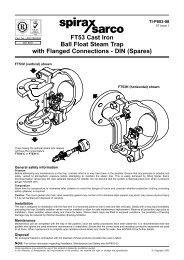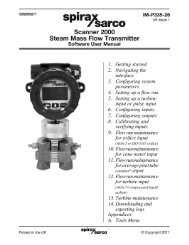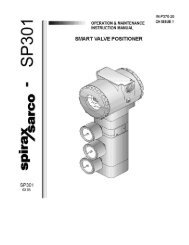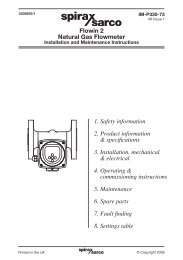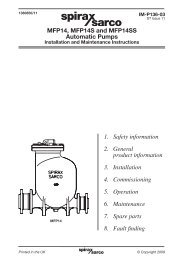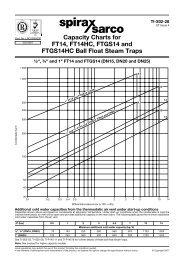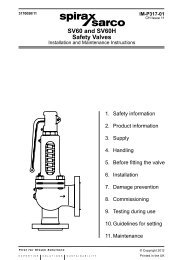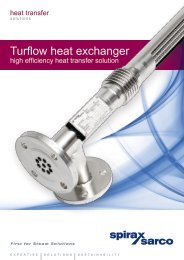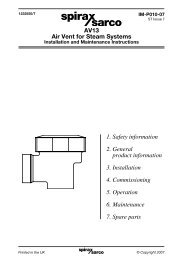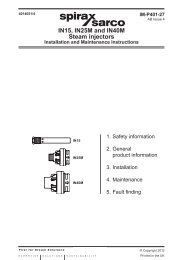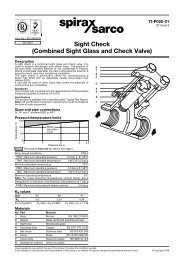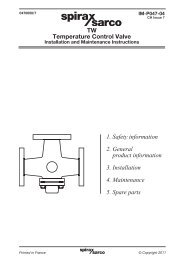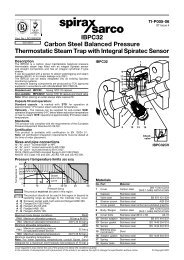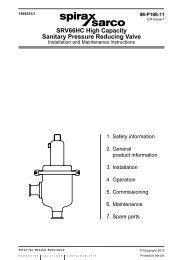Scanner 2000 Steam Mass Flow Transmitter ... - Spirax Sarco
Scanner 2000 Steam Mass Flow Transmitter ... - Spirax Sarco
Scanner 2000 Steam Mass Flow Transmitter ... - Spirax Sarco
You also want an ePaper? Increase the reach of your titles
YUMPU automatically turns print PDFs into web optimized ePapers that Google loves.
Section 1 <strong>Scanner</strong> ® <strong>2000</strong> microEFM<br />
<strong>Flow</strong> Rate and Fluid Property Calculations<br />
The <strong>Scanner</strong> <strong>2000</strong> calculates flow rates and fluid properties for natural gas, steam and liquid flow. The<br />
following descriptions identify the industry standards upon which these calculations are based.<br />
Natural Gas<br />
The <strong>Scanner</strong> <strong>2000</strong>’s natural gas calculations and data storage conform to AGA-3, AGA-7, AGA-8, API 21.1,<br />
and ISO-5167 industry standards. The flow calculations compensate for the effects of pressure, temperature,<br />
and gas composition to calculate the volume of gas measured at specified base conditions. These calculations<br />
typically require configuration of inputs including differential pressure, static pressure, process temperature,<br />
and for AGA-7, a turbine meter input.<br />
The integral multi-variable transmitter (MVT) is used to measure static pressure and differential pressure. A<br />
4-wire, 100-ohm platinum RTD is recommended for measuring process temperature. Where temperature is<br />
relatively constant, a fixed temperature value may be configured.<br />
Orifice Plate (DP Input). The <strong>Scanner</strong> <strong>2000</strong> calculates natural gas flow rate from orifice plates using<br />
calculation methods found in the AGA-3 or ISO-5167 measurement standards. The natural gas fluid<br />
properties, such as density and compressibility, are calculated in accordance with AGA-8 (Detail and Gross<br />
methods). Heating values are calculated in accordance with AGA Report 3, Part 3, Appendix F using the gas<br />
properties defined in GPA 2145. Molar mass (molecular weight) calculations are also based on GPA 2145.<br />
NuFlo Cone Meter (DP Input). The <strong>Scanner</strong> <strong>2000</strong> calculates natural gas flow rate from cone meters using<br />
industry-recognized algorithms identified in the NuFlo Cone Meter User Manual. The natural gas fluid<br />
properties, such as density and compressibility, are calculated in accordance with AGA-8 (Detail and Gross<br />
methods). Heating values are calculated in accordance with AGA Report 3, Part 3, Appendix F using the gas<br />
properties defined in GPA 2145. Molar mass (molecular weight) calculations are also based on GPA 2145.<br />
Gas Turbine Meter (Frequency Input). The <strong>Scanner</strong> <strong>2000</strong> calculates natural gas flow rate from a gas turbine<br />
meter using calculations found in the AGA-7 measurement standard. The natural gas fluid properties, such as<br />
density and compressibility, are calculated in accordance with AGA-8 (Detail and Gross methods). Heating<br />
values are calculated in accordance with AGA Report 3, Part 3, Appendix F using the gas properties defined in<br />
GPA 2145. Molar mass (molecular weight) calculations are also based on GPA 2145.<br />
Averaging Pitot Tube Meter (Annubar ® ). The <strong>Scanner</strong> <strong>2000</strong> calculates natural gas flow rate from an<br />
averaging pitot tube meter using calculations found in the ASME MFC-12M-2006 measurement standard.<br />
The natural gas fluid properties, such as density and compressibility, are calculated in accordance with<br />
AGA-8 (Detail and Gross methods). Heating values are calculated in accordance with AGA Report 3, Part 3,<br />
Appendix F using the gas properties defined in GPA 2145. Molar mass (molecular weight) calculations are<br />
also based on GPA 2145.<br />
<strong>Steam</strong><br />
The <strong>Scanner</strong> <strong>2000</strong>’s saturated steam calculations compensate for the effects of pressure, temperature, steam<br />
properties, and steam quality.<br />
Orifice Plate (DP Input). The <strong>Scanner</strong> <strong>2000</strong> supports steam measurement based on AGA-3 or ISO-5167<br />
flow rate methods for orifice plates. Fluid properties are calculated in accordance with the IAPWS Industrial-<br />
Formulation 1997 (IF-97) standard. Temperature is calculated according to IF-97 for saturated steam, based<br />
on static pressure. Therefore, an RTD is not required. The optional Chisholm and James wet correction<br />
methods are supported for the measurement of vapor and fluid.<br />
8



